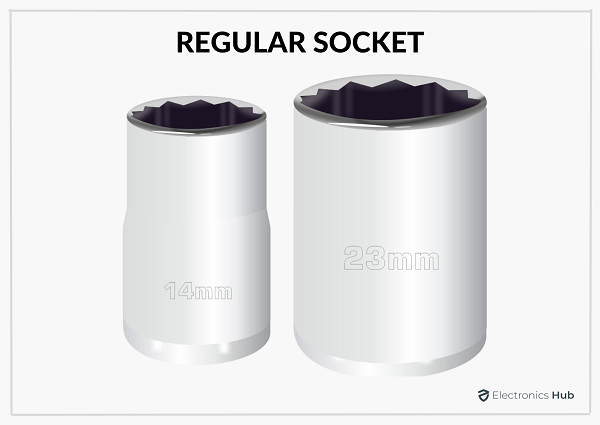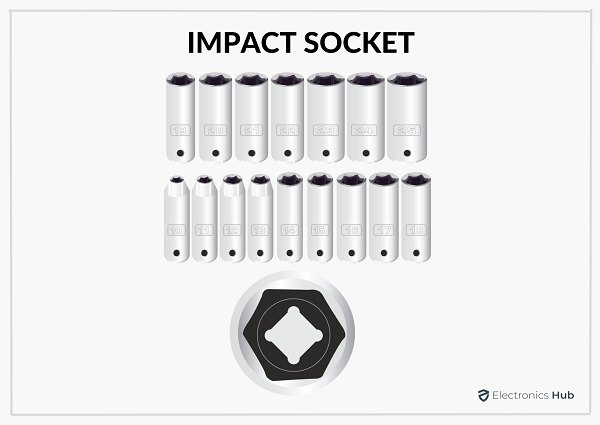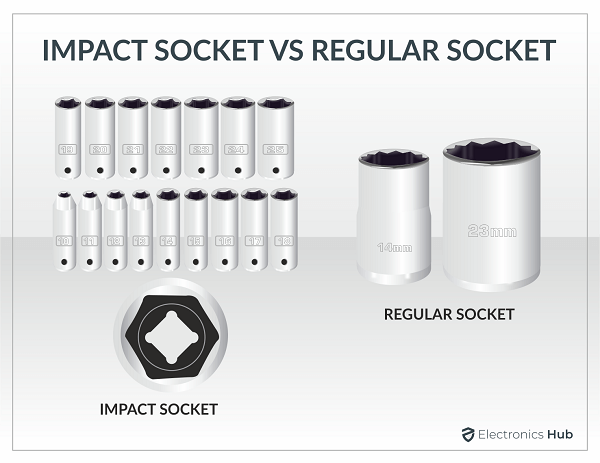A Socket is an important tool in the automotive industry. We attach this tool to a torque wrench, a socket wrench, a ratchet, or any similar hand-driven or powered turning tool to fasten or loosen nuts and bolts. If you are in the market looking for sockets for your garage or workshop, then you will come across two types of sockets. They are Regular Sockets and Impact Sockets. But what are the differences between these two? How to compare Impact Socket vs Regular Socket?
In this guide, we will take you through the basics of both a regular socket as well as an impact socket. We will take a look at their advantage and disadvantages. After that, we will make a comparison of the Impact Socket vs the Regular Socket and finally help you decide which is a better option for your needs.
Outline
ToggleWhat is a Regular Socket?

The advantage of the combination of a Socket Wrench and a Socket Set is by using a single wrench and multiple sockets, you can use the tool on fasteners of various sizes.
Types of Regular Sockets
To aid this, Sockets come in a variety of sizes and head shapes. The side that attaches to the Socket Wrench is the drive end of the socket. This is usually a recessed square slot to connect the square drive nose of the wrench.
The drive size of the Socket Wrench is an important specification and when you are buying a set of Regular Sockets, you need to check the drive size so that the sockets fit perfectly into the wrench. Some common drive sizes are 1/4-inch, 3/8-inch, and 1/2-inch.
Coming to the other end of the Socket, it is known as the Socket Head as this part of the socket is responsible for holding the fastener in order to tighten or loosen it.
Sockets come in different head shapes but the most common one is a Hex Head, which is a six-point socket and is also known as Hex Socket. This head shape is suitable for all regular nuts or bolts.
Next, we have a 12-point or 12-sided Socket Head. As the name suggests, this type of socket is suitable for nuts and bolts with 12 sides. Other than these two, Torx Socket and even one with Allen Key are also available.
Apart from the shape of the head, the length of the socket is also an important specification. You get Standard Sockets, Semi Deep Sockets (slightly longer), and Deep Sockets (even longer).
You can use Regular Sockets with simple Socket Wrenches (with or without a ratchet mechanism) or power tools such as Impact Wrenches or Air Ratchets.
What is an Impact Socket?

We have a better alternative in the form of Electrical and Pneumatic Tools. They are much more powerful and can also do the job faster. Air Ratchets and Impact Wrenches (both electric and pneumatic) are the two most popular types of power tools for working with fasteners.
Similar to hand tools, even power tools need Sockets of different shapes and sizes to work with different types of fasteners. While you can use Regular Sockets with low-torque or small fasteners, you need to consider Impact Sockets when you are working with Impact Wrenches.
So, what exactly is an Impact Socket? An Impact Socket is a tougher version of a Regular Socket. It has thicker walls than a regular socket and is made up of a different material.
If you are familiar with the working of an Impact Wrench, then you will appreciate the importance of an Impact Socket. An Impact Wrench does two things. It drives the Socket (to fasten or loosen) similar to a regular hand-powered Socket Wrench.
In addition to this, the Impact Wrench will also vibrate the socket in a to-and-fro motion. The combination of both these actions will help you in removing very tight nuts.
If you use a regular socket for this job, the high torque and impact (vibrations) from the wrench may cause cracks in the walls of the socket.
An Impact Socket is purpose-built to tackle these situations. The thicker walls of the Impact Socket mean they can sustain the high torque of the Impact Wrench and also the vibrations of the impact.
Another thing that benefits the Impact Socket is the material (or metal) they are made up of, which is Chrome Molybdenum Alloy Steel or Chrome Moly Steel (or simply Chromoly Steel).
This metal has high tensile strength than regular steel and as a result, the overall elasticity of the Socket increases. So, instead of breaking or forming cracks, the high elasticity nature of Impact Sockets allows them to bend under high-torque conditions without any structural damage.
Types of Impact Sockets
Similar to Regular Sockets, even Impact Sockets come in different drive sizes and Socket Heads shapes. They are also available as Standard and Deep Impact Sockets.
If you want to reach even deeper fasteners, you can make use of Impact Extension Bars.
Impact Socket vs Regular Socket: Differences

1. Material
If you look at both Impact Sockets and Regular Sockets, you will immediately notice a difference in their color. Regular Sockets have a “chrome” color while Impact Sockets are slightly darker (close to black). The difference in colors is due to the different types of materials they are made from.
Standard or Regular Sockets are usually made from Chrome Vanadium Alloy Steel. It contains 0.18% Vanadium, 0.7 to 0.9% Manganese, and 0.5% Carbon among other things.
Coming to Impact Sockets, we already mentioned before that they are made from Chromoly Steel (an alloy of Chromium and Molybdenum). This type of steel comes under the 41XX Steel under the SAE Family of steel grades. Apart from Chromium and Molybdenum, they also contain minute quantities of Phosphorus, Manganese, Silicon, and Sulphur.
The dark color of Impact Sockets is a result of the carburization of the surface. This will toughen the material and also acts as a visual distinguisher (from regular sockets).
2. Drive Sizes and Socket Shapes
Both regular sockets and impact sockets are available in a wide range of drive sizes, socket shapes, and socket sizes.
Regular Sockets are available in 1/4-inch, 3/8-inch, 1/2-inch, and 3/4-inch drive sizes. When we say drive sizes, we are referring to the size of the square drive that connects to the Wrench.
Impact Sockets are also available in all the drive sizes that we mentioned before. In addition, they are also available in a much larger 1-inch drive size as well.
Comping to the Socket Shapes, both Regular and Impact Sockets are very popular with HEX shapes sockets (6-sided sockets). You can also get both of them with 12-sided sockets and Torx Sockets.
Regular Sockets also come with a Hex or Allen Key, where you have to insert the Hex Wrench into a slot on top of the fastener.
The size of the Socket is also an important factor as different sizes allow you to reach fasteners in tight or unreachable locations. The three common sizes are Standard Sockets, Semi Deep Sockets, and Deep Sockets.
3. Applications
As a basic rule, many automotive technicians and experts usually do not recommend using regular sockets with impact wrenches (whether electric or compressed air powered) for safety reasons.
The high torque and pressure from impact wrenches can easily bend the regular sockets. As they do not have the tensile strength, they will crack or in a worse case break with shrapnel flying all around.
This causes harm to technicians and personnel in garages or workshops. The material and construction of an Impact Wrench prevent this type of incident from happening.
So, use Regular Sockets with hand tools such as socket wrenches and ratchet wrenches. For power tools such as Impact Wrenches, use Impact Sockets.
You can use Impact Sockets with hand tools but we do not recommend using regular tools with impact wrenches.
Both Regular Sockets and Impact Sockets have extensive applications in the automotive industry. They help technicians and repair personnel in tightening or loosening different fasteners (usually nuts and bolts) all around a vehicle.
4. Additional Features
There is an important feature of Impact Sockets. If you observe the end of the impact socket (at the drive end), you will see a tiny hole. You have to align this hole with the hole on the square head of the impact wrench and insert a locking pin.
After that, you can cover the hole with an O Ring so that the pin doesn’t come out easily. This locking mechanism helps the Impact Socket stay in connection with the square head at all times.
It gives the socket an additional safety mechanism and helps it against wobbling or even coming off due to severe vibrations.
Comparison of Impact Socket and Regular Socket
Let us make a quick side-by-side Impact Socket vs Regular Socket Comparison table.
| Parameter | Regular Socket | Impact Socket |
| Material | Chromium – Vanadium Alloy Steel | Chromium-Molybdenum Alloy Steel |
| Color | Shiny or Dull “Chrome” Color | Dark Carbon Color |
| Drive Size (Square Drive Head) | 1/4-inch
3/8-inch 1/2-inch 3/4-inch |
1/4-inch
3/8-inch 1/2-inch 3/4-inch 1-inch |
| Common Socket Shapes | Hex, 12-Sided, Torx, Allen Key | Hex and 12-Sided |
| Common Socket Sizes | Standard Sockets
Semi Deep Sockets Deep Sockets |
Standard Sockets
Deep Sockets |
| Cost | You can get a typical 30 – 40 Piece Socket Set for $25 | You can get a typical 33-piece Impact Socket Set for $45 |
| Applications | Use it with hand tools such as Socket Wrenches and Ratchet Wrenches | Use it with power tools such as electric or pneumatic Impact Wrenches |
Which One to Buy, an Impact Socket or a Regular Socket?
If you go to a local tool and hardware store or check online, you will notice that Socket options, be it Regular or Impact, are usually available in Sets of different sizes. Depending on the set you choose, you will get all the sockets with a single drive size or multiple drive sizes.
Coming to the important question, “Which one should you buy, an Impact Socket or a Regular Socket?”, we recommend you get to have both sets.
From the previous discussion, we made it clear that regular sockets are suitable with socket wrenches and ratchet wrenches, or other similar hand tools. The torque on the sockets from socket wrenches isn’t that high. So, you can use them to tighten or loosen nuts and bolts with your hand.
The job of tightening or loosening nuts with hand tools is much quicker, especially if they are accessible and require low torque.
Impact Sockets, on the other hand, are suitable for power tools such as Air Ratchets or Impact Wrenches that are either electric or compressed air powered. These sockets are built to withstand the high torque and extensive vibrations from the impact wrenches.
When you are working on an automobile, some fasteners are easily accessible and do not need high torque. For such nuts and bolts, you can get away with a ratcheting wrench and regular sockets.
But for bigger and tougher fasteners, you need high torque from the impact wrenches and also the impact sockets to work without cracking or shattering. Nuts on the engine block and lug nuts on the wheel are a couple of examples.
It is clear that while working on a car or truck, you need both Impact Sockets as well as Regular Sockets. Even though you can use Impact Sockets with hand tools, we recommend you get separate sets of Impact Sockets and Regular Sockets for respective tools and jobs.
Conclusion
Sockets are very useful tools in the automotive industry. You work with a lot of fasteners whenever you are doing a service, repair, or maintenance job on an automobile.
There are two types of sockets in terms of their strength and intended tool. They are Regular or Standard Sockets and Impact Sockets.
In this guide, we saw the basics of both the regular socket and the impact socket. After that, we looked at the similarities and differences between them.
Later, we made a simple Impact Socket vs Regular Socket comparison with the help of a table. Finally, we concluded the guide with a helpful “buying guide”.
We hope that this guide could help you understand the differences between a Regular Socket and an Impact Socket. If you feel we missed something or want us to add anything do let us know in the comments section. It will not only help us but even other readers as well.

